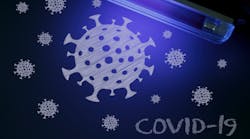Light has always been a comforting thing. Consider how the light from our faraway sun brings life to the planet, and even the smallest light can make the overpowering darkness a little less scary. Likewise, ultraviolet light helps make the dental operatory a much safer and less scary place.
When disinfecting a dental operatory, we must wipe down multiple surfaces between patients, sterilize instruments and handpieces, and utilize barriers to make treatment as safe as possible for patients. But what about the surfaces that are more challenging to keep clean, such as the electronics used during the course of patient care? Computer keyboards, digital cameras, remote controls, and computer mice are difficult to avoid contaminating, especially when you factor in the production of dental aerosols and the fact that they can linger in the air long after the patient has left the room.
There is little argument that it is imperative in dentistry to do everything we can to keep patients safe. This is where an ultraviolet disinfecting light can become a tool to make infection control for the workplace a little easier to achieve. If you don’t know much about UV lights, you are not alone. I was in the dark myself until I began to hear about other dental offices utilizing them once COVID-19 came into the picture, so I decided that I needed to learn as much as possible on this topic. I had heard about special UV lights that could be installed in the ceiling, as well as smaller countertop disinfection units that could hold and disinfect small items and disinfection wands that could be used almost anywhere.
How UVC lights work
I started off by doing a little research to see if UV lights were proven to be effective or if this was just hype. I discovered that the type of UV radiation used in these devices is called ultraviolet-C (UVC) and has been used for decades to decrease the spread of bacteria as explained by the US Food and Drug Administration. This special type of light can be used on air, water, and nonporous surfaces.1 The disinfection of water is currently the most widely accepted application for UVC light.2
As far as ultraviolet light is concerned, there are three different types: ultraviolet-A, -B, and -C.3 Ultraviolet-A is the most common type that we are exposed to from the sun, accounting for 95% of the ultraviolet radiation landing on the earth’s surface. It has the longest wavelength. Ultraviolet-B has a medium wavelength and is the damaging light that is responsible for sunburns, skin cancer, and aging. Ultraviolet-C, with the highest frequency, is the most damaging type of UV radiation. UVC does not naturally reach ground level as it is filtered out by the earth’s atmosphere.
The wavelength of UV radiation is strictly defined in the range of 210–328 nanometers (nm).4 Its maximum bactericidal effect occurs from 240–280 nm. This type of light is effective against microorganisms, because it causes the creation of thymine dimers, or double bonds. Thymine is one of the basic components of DNA. Permanent cellular damage occurs when this change to thymine occurs and further replication is inhibited.5 It is also important to consider that UVC light is not proven to destroy COVID-19, although it has been shown to be effective against other coronaviruses, but only when a specific wavelength of light is used.6
Trying out a UVC light for myself
I decided to try out a UV disinfecting wand as it was the most readily available option for me. Whole-room disinfecting lights have drawbacks in that they must be utilized only when the room is completely empty; as such they are often equipped with motion sensors.5 Smaller countertop units are limited by the size of items they are able to disinfect. UVC wands, however, are relatively inexpensive and have the advantage of being easily movable from room to room.
The wand I tried out is manufactured by Dine Corp. The company claims that the disinfecting wand is designed to kill up to 99.9% of bacteria and viruses.7 There are two different models available. The first is 12 inches by 1.5 inches. It is rechargeable and provides three hours of continuous usage. It is recommended that the light from this wand be used three-to-four inches away from the desired surface for a minimum of 10 seconds per inch. The light wavelength emitted is 264 nm, which is in the correct range for disinfecting bacteria and viruses on surfaces.
The second wand model is a foldable UVC disinfection wand that is small enough to fit in a pocket. When disinfecting a surface, this wand is held two to three inches above the area it is scanning in two-inch sections for 20–30 seconds. The wavelength of light emitted ranges from 265–280 nm. After being charged by a USB cable, the foldable wand can be used for up to 120 minutes.
One caution about this product is that it absolutely cannot be shined directly into anyone’s eyes. It is also not to be used on human skin under any circumstances. As mentioned above, this type of UV light can be highly damaging. Although it may be tempting to use it directly on skin, it can cause burns within a matter of seconds.6 The foldable wand made by Dine Corp has a safety feature that automatically turns off the unit if it is facing upward.7 UVC safety goggles can also be purchased.
I have found that the foldable wand is convenient, lightweight, and easy to use in the dental operatory. It is reassuring to be able to further disinfect the electronics I use on a regular basis with a no-touch system. I often utilize tape and plastic barriers to cover my keyboard and mouse, but I’ve never been sure whether this action is effective enough. The UV wand has definitely made my operatory feel like a safer place with its comforting purple light hard at work.
After getting good results from using this product in the operatory, I also started using the foldable wand on some of my personal items that can be difficult to keep clean—e.g., my car keys, cash, and cell phone. It has reassured me to know that these frequently touched and difficult-to-disinfect items are cleaner as I carry them around. I even took a wand on my trip to visit family in Florida this summer, and my children and I came back as healthy as ever.
If there is anything we have learned in dentistry since COVID-19, it is that we must be hypervigilant about infection control. Keeping our eyes open for various ways to accomplish this objective is the best way to keep our patients and ourselves safe. New disinfection measures, such as use of a UVC sanitizing light, can help us pave the path for a safer practice of dentistry for years to come.
References
1. UV lights and lamps: ultraviolet-C radiation, disinfection, and coronavirus. US Food and Drug Administration. August 19, 2020. https://www.fda.gov/medical-devices/coronavirus-covid-19-and-medical-devices/uv-lights-and-lamps-ultraviolet-c-radiation-disinfection-and-coronavirus
2. Reed NG. The history of ultraviolet germicidal irradiation for air disinfection. Public Health Rep. 2010;125(1):15-27. doi:10.1177/003335491012500105
3. Radiation: ultraviolet (UV) radiation. World Health Organization. March 9, 2016. https://www.who.int/uv/faq/whatisuv/en/index2.html
4. Miscellaneous inactivating agents. Guidelines for disinfection and sterilization in healthcare facilities (2008). Centers for Disease Control and Prevention. National Center for Emerging and Zoonotic Infectious Diseases (NCEZID). Division of Healthcare Quality Promotion (DHQP). Updated September 18, 2016. https://www.cdc.gov/infectioncontrol/guidelines/disinfection/disinfection-methods/miscellaneous.html
5. Casini B, Tuvo B, Cristina ML, et al. Evaluation of an ultraviolet C (UVC) light-emitting device for disinfection of high touch surfaces in hospital critical areas. Int J Environ Res Public Health. 2019;16(19):3572. doi:10.3390/ijerph16193572
6. Gorvett Z. Can you kill coronavirus with UV light? BBC Future. April 24, 2020. https://www.bbc.com/future/article/20200327-can-you-kill-coronavirus-with-uv-light
7. In office and at home UV sterilization products. Dine Corp. https://dinecorp.com/product-category/uv-sterilization-products/







